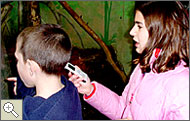|
|
 |
 |
 |
|
The Smithsonian-Jamestown Podcast Project |
|
Before the Visit
-
During the Visit
-
After the Visit
-
Acknowledgements
|
 |
 |
 |

After the Visit
The students went on to make recordings in which they listed some of the things they learned. From these, we can tell that the group project allowed a lot of room for the individual interests of each student. The animal facts that the students report are clearly those that most stirred their imagination: Elephants “eat 125 pounds of food per day” and “have about four thousand nerves in their trunk.” The cheetah “can run sixty miles per hour.” At just six months of age, cheetah cubs “leave the house.”
The students themselves used editing software to put together the audio for all of the podcast episodes. They added music to some of the recordings and selected still images to accompany the audio as a slide show. The class submitted the podcast to iTunes for review. When it was approved, it became available for free download at the iTunes Store, under “Education.”
“Using technology before, during, and after the visits really connected the students to what they were doing,” said fifth-grade teacher Rachel Lott.
One of the themes that emerged from the project was the “connection between form and function in the animals.” In the podcast, too, form followed function.
“We started the podcast with questions,” said Ms. Gagliolo, “and we had more and more questions as we went along.”
Jamestown Elementary Smithsonian Project Website
|
 |
 |
 |
 |

Recording Behavior
|
 |
 |

At the Smithsonian National Zoological Park, the students used microphone-equipped iPods to record their descriptions of the animals they watched inside the Small Mammal House.
|
 |
 |
 |
|




|
|
|

